Dysport®
Dysport, like Botox, is an injectable neuromodulator used to treat fine lines and wrinkles, such as frown lines. Fine lines are typically among the first signs of aging to develop and may induce feelings of self-consciousness for many. Whether it’s worry lines that deepen or crow’s feet that appear when we smile, dynamic facial wrinkles can make us look much older than we truly feel. Dysport, Botox, and Xeomin are neuromodulators that have gained popularity due to the ease of injections, minimal downtime, few potential mild side effects, and long-lasting, natural-looking cosmetic results. Dysport injections rank among the most popular non-invasive cosmetic treatment options in the United States, including in Dr. Green’s private NYC dermatology office.
Dysport is the brand name for abobotulinumtoxinA, a type of botulinum toxin A that received FDA approval in 2009. As a neuromodulator, Dysport inhibits nerve signaling to specific muscles. When injected into facial muscles, Dysport effectively “freezes” the muscle, limiting contractions and reducing the formation of dynamic wrinkles. Dysport is FDA-approved for treating glabellar lines (the lines between the eyebrows) but is often used off-label to address forehead lines, crow’ s feet (around the eyes), and TMJ. The cosmetic effects of Dysport typically last for 3 to 4 months. Dysport treatments, like other injectable neurotoxins, should always be performed by an expert injector and a board-certified dermatologist, such as Dr. Michele Green in NYC.
If you’re frustrated by dynamic facial wrinkles and fine lines, Dr. Green is here to help. Dr. Michele Green is a board-certified cosmetic dermatologist renowned for providing the “best Botox” and dermal filler injections in New York City. With over two and a half decades of experience, she is consistently recognized as one of NYC’s leading dermatologists by Castle Connolly, New York Magazine, Super Doctors, and the New York Times for her dedication to patients and expertise. She takes a holistic approach and embraces a less-is-more philosophy regarding cosmetic treatments for anti-aging and facial rejuvenation. When you consult with Dr. Green at her private dermatology office in Manhattan’s Upper East Side neighborhood, she will collaborate with you to develop a customized treatment plan tailored to your specific skin concerns and personal aesthetic goals.
What are Dysport injections?
Dysport is a cosmetic injectable neurotoxin known as botulinum toxin, used to treat moderate to severe frown lines (the glabellar lines), forehead wrinkles, and crow’s feet (the lines around the eyes). Dysport received its FDA approval in 2009 for cosmetic uses and various other medical conditions. Dysport contains the active ingredient abobotulinumtoxinA, which acts on the neuromuscular junction, blocking nerve signals to the muscles. The targeted muscles are then unable to contract, preventing the skin from folding into facial wrinkles. This reduction in muscle activity decreases the appearance of dynamic wrinkles on the face, helping to smooth the skin’s surface. The cosmetic effects of Dysport last for 3 to 4 months. Dysport also contains human albumin and sucrose. Human albumin is a protein that serves as a stabilizing agent, protecting the botulinum toxin molecule during manufacturing, storage, and administration.
Who manufactures Dysport?
Galderma is the pharmaceutical giant behind the neuromodulator Dysport. Today, there are many neuromodulators on the market, including Botox, Xeomin, Dysport, and more. In 2019, Galderma Laboratories celebrated ten full years of FDA-approved Dysport treatments in the United States. During that time, the neuromodulator gained wide popularity for reducing facial lines. Dysport injections are safely approved for use in 72 different countries, and over 25 years of successful clinical trials have proven them safe for both therapeutic and aesthetic use. Galderma is a popular innovator in cosmetic dermatology, with products that include Restylane®, Sculptra®, Cetaphil® brand skincare, and Differin acne gel, among others. Galderma also commits to sustainable consumption and ethical practices to help preserve resources for future generations.
What is Dysport used for?
Dysport is a treatment that can be applied for both cosmetic and medical purposes. Cosmetically, it is FDA-approved for treating moderate to severe frown lines between your eyebrows (the glabellar lines). However, it is often used off-label in other areas, such as forehead wrinkles and crow’s feet (the lines around the eyes). Dysport is an injectable neurotoxin, specifically botulinum toxin type A, which essentially “freezes” targeted muscles by blocking the nerve signals. Dynamic wrinkles form due to the repetitive contraction of facial muscles while making expressions. Over time, this repeated muscle movement leads to fine lines and deeper wrinkles becoming etched into the skin. By limiting the movement of the facial muscles that contribute to fine lines, Dysport treatment proves to be the most effective non-invasive cosmetic procedure for diminishing the appearance of dynamic facial wrinkles.
Dysport has also received FDA approval to treat certain medical conditions. Specifically, it is approved for cervical dystonia, also known as spasmodic torticollis and limb spasticity. Both conditions are associated with involuntary muscle spasms. Cervical dystonia is a rare medical condition that causes the neck muscles to contract involuntarily into abnormal positions, leading to painful and disabling twisting movements of the head and neck. There is no known cause or cure for cervical dystonia. However, symptoms can be managed with Dysport injections into the affected muscles, which temporarily block the brain signals that instruct the muscles to contract. Spasticity is a condition characterized by increased muscle tone and stiffness, leading to involuntary muscle contractions and difficulty with movement. Dysport decreases muscle contractions, minimizing the symptoms of lump spasticity. Dysport treatment for these medical conditions should be recommended and performed by a specialist.
Where is Dysport used cosmetically?
Dysport is only FDA-approved to treat the frown lines between the brows; however, skilled injectors such as dermatologists and plastic surgeons use Dysport off-label to treat wrinkles across the face, including:
- Glabella lines (worry lines)
- Forehead lines (frown lines)
- Crow’s feet (lines around the eyes)
- Bunny lines (lines from squinting on the nose)
- Brow lift
- Gummy smile and upper lip lines
- Neck cords or bands
- Wrinkles or dimpling of the chin area
- Down-turned corners of the mouth (DAO muscle)
- Masseter muscles for TMJ pain and facial slimming
What is the process for getting Dysport Injections?
Before receiving Dysport injections, you will meet with Dr. Green at her private dermatology office in NYC for a consultation. During this consultation, you can discuss your specific concerns and desired aesthetic outcomes. Medical photos will be taken to help determine the best cosmetic treatment for you and to track the results. Dr. Green will collect a comprehensive medical history, including supplements and prescriptions, review any previous cosmetic procedures, and assess your unique facial anatomy. Your Dysport injections may occur on the day of your consultation or be scheduled for a later date based on your preference.
To prepare for your Dysport treatment, we recommend avoiding blood thinners like aspirin, Aleve, Motrin, multivitamins, or fish oil for one week prior to your procedure to reduce the risk of bruising at the injection sites. Patients who are sensitive to pain can apply a topical numbing cream one hour before the procedure to lessen discomfort. Upon arrival at the office, the treatment area will be sterilized and prepared for the procedure. Dr. Green will mark the injection sites and perform the procedure with a small needle. An ice pack will be applied to the treatment area immediately after to help minimize any potential swelling. The most common side effect is mild bruising, which will resolve on its own. Dr. Green typically requests that patients return in two weeks for a follow-up to evaluate the cosmetic results and determine if additional Dysport is needed to achieve the best aesthetic outcome.
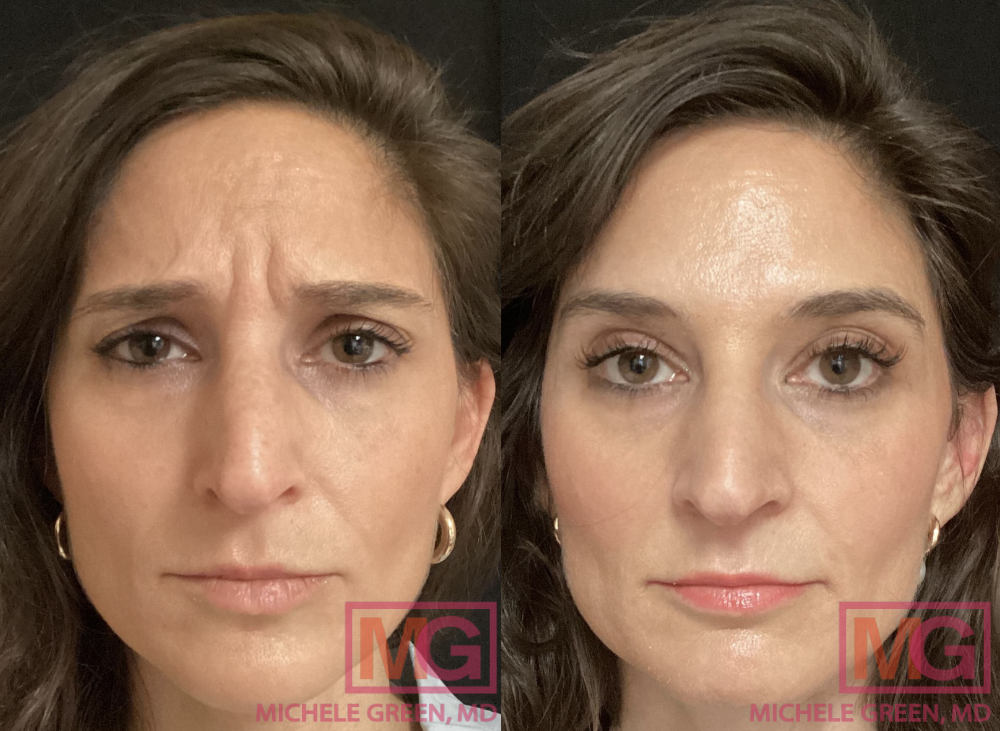
What are the side effects of Dysport treatment?
In general, side effects from Dysport injections are similar to Botox injections and are very mild. Common side effects of Dysport include:
- Bruising
- Localized swelling at the site of injection
- Temporary droopy eyelids
- Headaches
Occasionally, Dysport injections can lead to serious side effects. These possible side effects include:
- Dry eyes, tearing, light sensitivity
- Allergic reaction (red, itchy welts, wheezing, or asthmatic symptoms)
- Difficulty swallowing, breathing, or talking
- Respiratory tract infection
- Muscle weakness
- The distant spread of toxin
More Serious side effects that may occur include blurred vision, drooping eyelids, double vision, and allergic reactions. For cosmetic injectable treatments like Dysport, it’s essential to have updated medical history information from your healthcare provider. If you experience any breathing difficulties or severe adverse reactions, seek medical advice immediately. In rare instances, botulinum toxin can cause adverse effects if it spreads from the injection site, including but not limited to paralysis, respiratory failure, and even death. Due to these risks, you should always rely on a board-certified dermatologist or plastic surgeon, such as Dr. Michele Green, for proper injection and accurate dosage.
When does Dysport “kick in”?
Patients often wonder, “How long does it take for Dysport to kick in?” Most patients notice the effects of Dysport within a few days of their initial treatment. Typically, patients see positive results from Dysport within four days, a couple of days after any initial swelling at the injection site has subsided. For some patients, it may take up to two weeks for the full effects to become apparent. However, in general, it will only take a few days for optimal results to show. Dr. Green recommends that all her Dysport patients return for a follow-up two weeks after their cosmetic injections to ensure that their Dysport treatments are effective and that they achieve the best results.
What is the difference between Dysport, Botox, and Xeomin?
Dysport, Botox and Xeomin are three popular neuromodulator products with only a few differences. The main difference in results stems from the structure of the neuromodulator within each product. Each of these neurotoxins is comparable and effective.
Dysport and Botox work by inhibiting neurotransmitters that signal muscle contractions. Currently, the FDA approves Dysport only for treating glabellar or frown lines. Botox, on the other hand, is FDA-approved for forehead lines, crow’s feet, and glabellar lines. The efficacy, longevity, and treatment effects of Dysport and Botox are comparable. Dysport typically begins to take effect in just a few days, while Botox results may take longer, with full effects observable in about two weeks. Both Dysport and Botox have similar longevity of three to four months, although some patients note that one may last longer than the other. The dosages of Dysport and Botox vary, with the general guideline suggesting that one Botox unit is equivalent to three Dysport units. The formulations of Botox and Dysport differ slightly due to the proteins connected to the neurotoxin in each product. Research has indicated that Dysport has a larger spread area upon injection because of differences in the attached proteins. Both Botox and Dysport share the same recovery time and require no downtime.
Like Dysport and Botox, Xeomin is an injectable neuromodulator that utilizes botulinum toxin to relax the facial muscles responsible for dynamic wrinkles. Xeomin is an innovative variation that stands apart from Dysport and Botox because it contains no additives or accessory proteins in its formulation. This feature of Xeomin makes it an excellent cosmetic treatment option for patients who have developed antibody resistance to products similar to Botox. Antibody resistance is a frustrating issue that some patients can develop with the prolonged use of Botox. This is why Xeomin’s “naked” formulation represents an exciting advancement in the realm of neuromodulators.
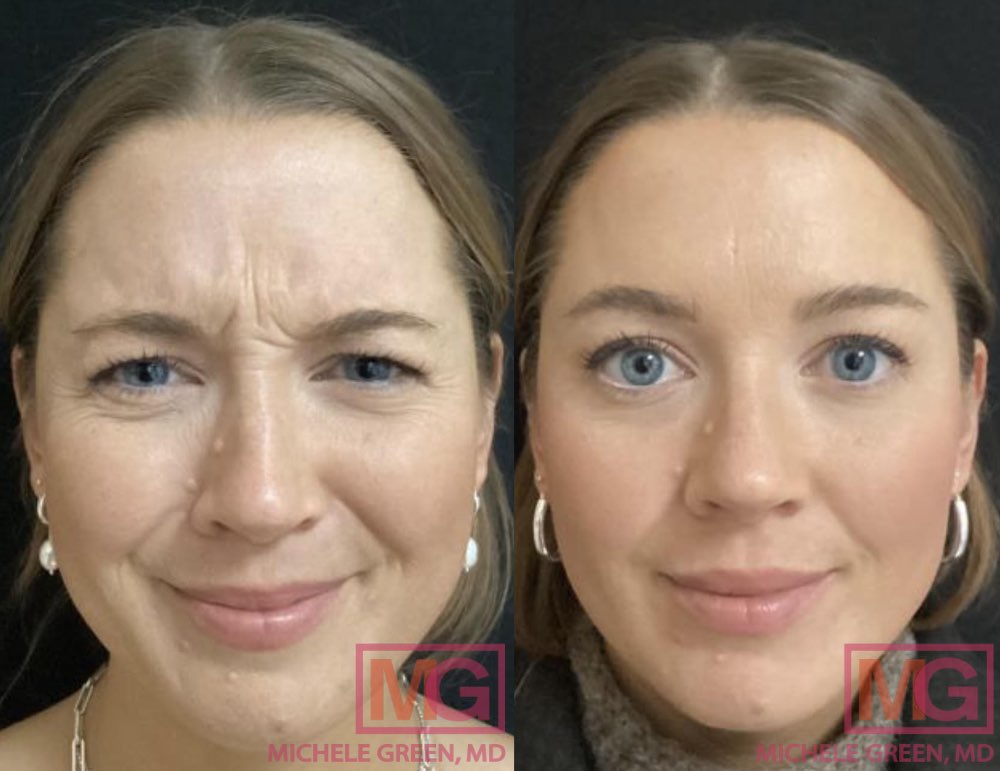
FAQs about Dysport Injections
Is Dysport Safe?
Yes! When administered by a board-certified healthcare professional, Dysport treatment is very safe. Dysport injections may cause mild side effects, such as pain or swelling at the injection site; however, when an inexperienced provider administers Dysport, the risk of severe, life-threatening side effects, like the spread of toxin effects, increases. For this reason, it’s crucial to work with an experienced, board-certified dermatologist, such as Dr. Michele Green. Dr. Green has the knowledge and experience to deliver safe and effective Dysport injections, ensuring natural-looking results.
While Dysport injections are overall safe, there are a few contraindications, such as an allergy to other botulinum toxin products, including Botox or Xeomin. Do not use Dysport if you are allergic to any of its ingredients, allergic to cow’s milk protein, have a skin infection at or near the injection sites, or are pregnant or breastfeeding. It is important to inform Dr. Green if you have any nerve or muscle conditions such as ALS (Lou Gehrig’s disease), myasthenia gravis, or Lambert-Eaton syndrome. Always let Dr. Green know if you are taking any prescription medications (including muscle relaxants, antibiotics for infection, allergy or cold medications, and sleep medicines), herbal supplements, or over-the-counter medications that could potentially interact with your Dysport treatment. It is advised to discontinue any blood thinners for at least one week before your Dysport injections.
When does Dysport peak?
Dysport takes time to set in, with some patients beginning to notice its effects within three to four days after the injections. The full effects peak two weeks after the injections, at which point the complete results become visible. Dysport results typically last for three to four months before the treatment begins to wear off. To maintain consistently stunning results, many patients choose to receive regular Dysport treatments three to four times a year. When you receive Dysport injections from an expert injector and board-certified cosmetic dermatologist, such as Dr. Michele Green in NYC, she can evaluate your cosmetic results two weeks after treatment to ensure they are optimal and perform any necessary touch-ups.
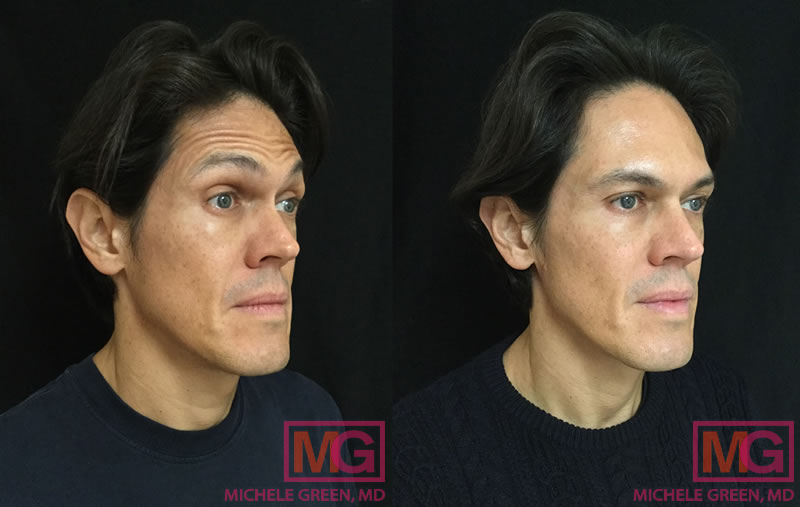
Male Dysport patient, before and after photo
How long does Dysport last?
The effects of Dysport generally last between 3 to 4 months, with some patients reporting results lasting up to 6 months. Studies indicate that repeated Dysport injections can continue to weaken the muscle and may extend the duration of the injection’s effects. Many patients undergo maintenance sessions three to four times a year to consistently enjoy its cosmetic benefits. When you consult with Dr. Green for your neuromodulator injections, she will work with you to develop a treatment schedule that meets your aesthetic needs and goals.
How long does Dysport take to work? How fast does Dysport work?
Patients often wonder, “How long until Dysport works?” Dysport injections have a quick onset, with patients enjoying the results within a few days of the initial treatment. After Dysport is injected, it generally takes four days for it to begin working. It can take up to two weeks for the full effects of Dysport to take effect. Dysport lasts for three to four months after the initial treatment, and maintenance sessions are recommended to maintain the best cosmetic results from your Dysport treatment.
How often do you get Dysport?
Most patients are thrilled with the results after a Dysport treatment, as the effects can last for up to four months for many. However, an excellent way to prolong the success of Dysport is to keep regular “touch-up” appointments. Dysport typically lasts for 3 to 4 months before the body metabolizes it. Many patients choose to have maintenance visits 3 to 4 times a year to achieve consistently impressive results. By continuing these maintenance sessions, patients can improve the effectiveness of the neuromodulator and, in some cases, may permanently reduce the severity of dynamic facial wrinkles and fine lines. During a consultation with board-certified cosmetic dermatologist Dr. Michele Green at her private office on Manhattan’s Upper East Side, she will work with you to develop a personalized rejuvenation treatment plan and timeline that best aligns with your needs, goals, and preferences.
Is Dysport a dermal filler?
Dysport is a neurotoxin that offers anti-aging benefits by preventing and softening dynamic wrinkles. Another popular non-surgical treatment is dermal filler injections. Dysport is made from the neuromodulator abobotulinumtoxinA, which is different from dermal filler products. It acts at the neuromuscular junction to stop the targeted muscle from contracting, preventing wrinkles from deepening. Dermal fillers can restore lost volume, enhance contours, and boost collagen production. Dysport can be combined with other dermal fillers, such as Restylane, Juvederm, and Sculptra, to help restore your face’s youthful features in a natural-looking manner.
Can Dysport cause headaches?
One uncommon side effect of Dysport injections is a headache that may occur shortly after the injections. This can result from other facial muscles contracting to compensate for the treated, relaxed muscle. If a headache develops, this side effect is temporary and should resolve as the treatment’s effects become fully apparent. In the meantime, pain and discomfort can be alleviated with over-the-counter pain medications such as Tylenol. Avoid using blood-thinning pain relief medications like aspirin or ibuprofen, as they can cause or worsen swelling and bruising after Dysport injections.
How many units of Dysport will I need?
The amount of The amount of The amount of Dysport required for each patient varies based on the strength of their facial muscles, the severity of facial wrinkles, and the size or number of treatment areas. Many patients seek to maintain a natural, youthful appearance during their treatment while avoiding the freezing of their facial muscles. Stronger muscles, like the masseter, typically require more units compared to those for crow’s feet. After your consultation, where you will discuss your aesthetic goals, Dr. Green will determine the exact number of units necessary for your Dysport treatment.
It’s important to note that Dysport does not contain the same concentration of botulinum toxin type A per unit as Botox® Cosmetic. Patients typically require more units when receiving Dysport injections than with Botox. Most injectors use a ratio of 3:1 for Dysport to Botox, indicating that 30 units of Dysport are nearly equivalent to 10 units of Botox, although no exact ratio exists between the two. Dr. Green was among the first dermatologists in NYC to offer Botox and Dysport injections for cosmetically improving the appearance of facial wrinkles and embraces a less-is-more approach, ensuring that patients see results without appearing “overdone.”
How many units of Dysport are needed for the forehead?
As the primary muscle of the forehead is relatively thin and flat compared to other facial muscles, forehead wrinkles can be treated with a moderate amount of Dysport. Generally, around 40 units of Dysport are needed, but this can vary from patient to patient. Depending on the severity of the fine lines on the forehead, the aesthetic goals of the patient, and their response to the injections, an individual may require anywhere from 20 to 90 units of Dysport in the area. Male patients often have stronger facial muscles than women and typically require more units of Dysport to achieve optimal rejuvenation results. The best way to determine how many units of Dysport are necessary for your facial rejuvenation treatment is to consult an expert injector and board-certified dermatologist, such as Dr. Michele Green in NYC. Dr. Green takes a holistic approach and embraces a less-is-more philosophy regarding anti-aging and rejuvenation treatments, customizing each patient’s treatment plan to best suit their specific needs and personal aesthetic goals.
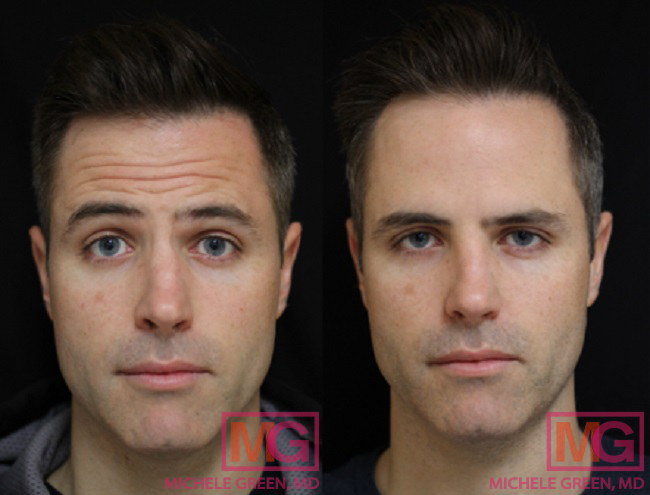
How much does Dysport cost?
Dysport treatment costs can vary depending on the experience level of the injector, the geographic location of the office in which you’re treated, the number of units you need per area, and the total number of areas being treated. Patients with stronger facial muscles or more severe dynamic facial wrinkles will likely require a greater number of units of Dysport to achieve their ideal results. It may be more inexpensive to have Dysport treatment with a nurse injector in a medical spa setting; however, it is always recommended to have neurotoxin injections with an experienced board-certified cosmetic dermatologist, such as Dr. Michele Green in NYC. Having Dysport injections with an expert injector like Dr. Green is the best way to prevent encountering unwanted side effects and guarantee that you achieve optimal cosmetic results. Dr. Green was among the first dermatologists in NYC to utilize injectable neurotoxins like Botox and Dysport for cosmetically treating facial wrinkles, including frown lines, glabellar lines, and crow’s feet. When you consult with Dr. Green at her private dermatology office in Manhattan’s Upper East Side neighborhood, she will work with you to develop a customized treatment plan for rejuvenation. The total cost of your Dysport treatment can be determined at that time.
What not to do after Dysport treatment
Only a few aftercare instructions are necessary after receiving cosmetic Dysport injections. Patients should avoid bending over for four hours and refrain from strenuous exercise for 24 hours post-treatment. It’s important to avoid heat sources such as saunas, steam rooms, hot tubs, and hot showers for 24 hours. Increasing body temperature after Dysport injections can elevate blood flow and cause or worsen swelling near the injection sites. Patients should also abstain from blood thinners for an additional week to minimize the risk of bruising. Those prone to bruising may take Arnika, an herbal supplement, for several days to help prevent bruising and accelerate the healing of any bruises that occur. When you receive Dysport treatment from board-certified dermatologist Dr. Michele Green in NYC, she will provide you with all necessary aftercare instructions to achieve and maintain optimal results.
How long after Dysport can you workout?
While exercise benefits cardiovascular health and overall well-being, it should be avoided for 24 hours after Dysport injections. Exercise raises heart rate and blood pressure, may cause patients to bend into an inverted position, and can apply excessive pressure to the injected areas. Vigorous exercise, such as running, jogging, or biking, can increase heart rate, blood flow, and body temperature, raising the risk of swelling, bruising, infection, and Dysport migration. Yoga and Pilates, in particular, may involve holding inversions, which could interfere with how Dysport settles into the muscle. Any pressure applied may cause the Dysport to move from the injection site — certain activities like cycling or swimming require head or facial gear that can exert pressure on common injection sites. Avoiding exercise for 24 hours after the initial injections is essential for optimal Dysport results.
Does Dysport last longer than Botox?
The effects of Dysport last for three to four months, similar to Botox. The longevity of both Dysport and Botox depends on the rate at which the body metabolizes the neuromodulator. Some patients report that Dysport lasts longer than Botox, while others claim that Botox lasts longer. It all depends on your body and how quickly it metabolizes the neuromodulator. Continuing maintenance treatments of Dysport will weaken the muscles, enhance the product’s effectiveness, and significantly reduce the appearance of fine lines and deep facial wrinkles.
Is Dysport cheaper than Botox?
The cost of neuromodulator treatment varies from patient to patient, depending on the areas being treated and the location of the treatment. Dysport and Botox are both neurotoxins with similar safety and efficacy profiles. However, the number of units is not interchangeable; one unit of Botox is approximately equivalent to three units of Dysport. For instance, treating the glabellar lines between the eyebrows may require 20 units of Botox or 50 units of Dysport. Your geographic location and the expertise of your injector influence the cost of Dysport and Botox. While medical spas may offer lower rates, it is important to choose an experienced injector, such as board-certified Dr. Green, to avoid unwanted side effects, ensure safety, and achieve optimal results.
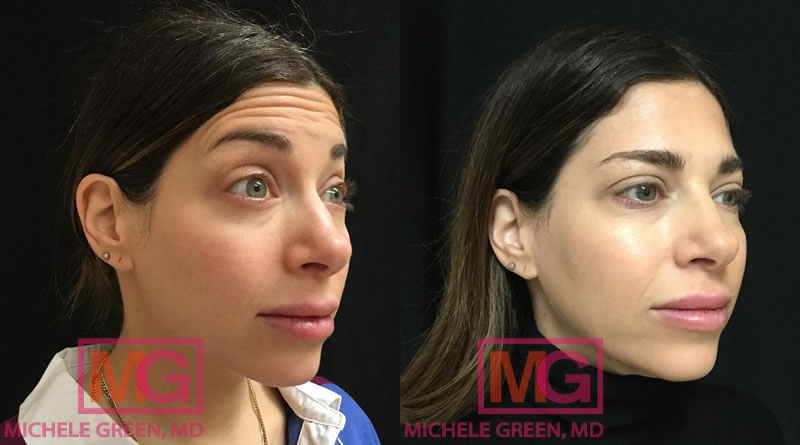
Is Dysport better than Botox?
Both treatment options are equally effective and can often be used interchangeably for facial rejuvenation. Dysport and Botox are both neurotoxins derived from the bacterium Clostridium botulinum. When injected, these neuromodulators inhibit nerve signaling to muscles, effectively relaxing and “freezing” the muscles at the injection site to soften dynamic wrinkles. The primary difference between Botox and Dysport lies in the type of complex protein associated with the botulinum toxin molecules. The protein linked to Dysport allows it to diffuse 1-3 cm from the injection site, while the protein bound to Botox enables diffusion of only half a centimeter. In addition to affecting the diffusion of the neuromodulator, the complexing protein can influence the duration and strength of treatment.
With repeated injections of the same neuromodulator, some patients may develop antibodies to the complexing protein. When this occurs, patients can become resistant to the toxin’s effects, leading to diminished and shorter-lasting results. Currently, Dysport is approved only for treating moderate to severe glabellar lines. At the same time, Botox is FDA-approved for addressing forehead lines and crow’s feet (lines around the eyes) in addition to glabellar lines. Both Dysport and Botox share the same safety profile, duration, and side effects. Dr. Green offers various neuromodulator injections to patients visiting her NYC-based practice and will assist you in determining which injectable is most suitable for you.
What is the best neuromodulator to use?
When considering which neuromodulator to use for rejuvenation treatment, there is no definitive “best” option. Each formulation offers unique benefits and should be selected based on the patient’s specific needs and preferences. For instance, patients who have developed antibody resistance to Dysport or Botox may find Xeomin a suitable choice to maintain the benefits of neuromodulator injections. Conversely, some patients believe that one neuromodulator lasts longer than another and prefer those with extended effects. During your consultation with Dr. Green, she will collaborate with you to determine the most appropriate neuromodulator, taking into account your medical history, individual requirements, and aesthetic goals.
How do I get started with Dysport Injections today?
If you notice fine lines and wrinkles forming from repeated facial expressions, or if you want to prevent wrinkles from developing, Dysport is here to help. Cosmetic injectables like Dysport are among the most popular non-invasive cosmetic treatments in the United States and in private dermatology offices due to their unmatched ability to address dynamic wrinkles. By effectively “freezing” the muscles responsible for these lines, Dysport smooths the skin’s surface for a youthful, natural-looking appearance. Patients appreciate Dysport’s long-lasting anti-aging and rejuvenation effects, as well as the convenience of treatment, minimal downtime, and few side effects. The effects of Dysport last approximately three to four months and can be maintained with regular treatment sessions. Dysport injections should always be performed by an expert injector such as Dr. Green, who has been incorporating Dysport into her patients’ treatment plans for years to achieve facial rejuvenation.
Dr. Michele Green, based in New York City, is an internationally recognized board-certified dermatologist with over twenty-five years of experience providing top-quality non-invasive cosmetic procedures, including Dysport, to a discerning clientele worldwide. She has been recognized by Castle Connolly, Super Doctors, New York Magazine, and The New York Times for her commitment to patient care and expertise. Dr. Green adopts a holistic approach and a less-is-more philosophy in facial rejuvenation, customizing each patient’s treatment plan to include a combination of cosmetic treatments and specially formulated skincare products that best address unique concerns and aesthetic goals. To learn more about non-invasive pan-facial rejuvenation, schedule a consultation with Dr. Green at her private dermatology office in Manhattan’s Upper East Side by calling 212-535-3088 or reaching out online.
 212-535-3088
212-535-3088